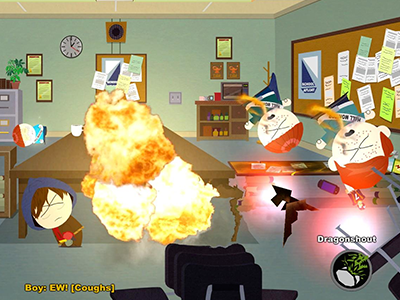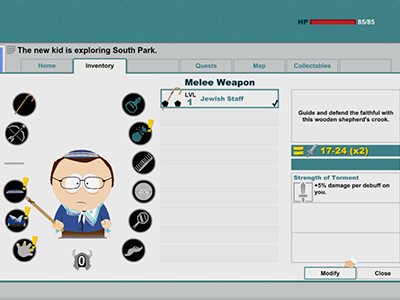So yesterday I beat South Park: The Stick of Truth. I loved it. I’ve always been a fan of South Park—its blend of cultural satire and immature toilet humor usually works surprisingly well. And I enjoy how episodes often call back to previous episodes. There’s a continuity to the series, which isn’t something that people might expect from that kind of show. And that continuity goes a long way towards making the world, characters and story of Stick of Truth so enjoyable, despite the relatively short (compared to most full-length RPGs) playtime.
But I’m not here to write a review of the game. You can find those all over the place. In fbb fashion, I want to take a hard look at the gameplay.
And South Park: Stick of Truth has some amazing RPG gameplay that went well above my expectations.
Gameplay-wise, Stick of Truth feels a lot like Paper Mario. And that’s a good thing—Paper Mario‘s not only one of my personal favorite games, but it’s a great example of an RPG battle system that promotes a lot of interactivity and gameplay that goes beyond scrolling through menus. Stick of Truth brings those same elements to its battle system while also innovating in a lot of ways that make the player feel good about what he’s doing. Even more—Stick of Truth goes beyond most RPGs in the ways it lets the player interact with the environment outside of battles.
The Battle System
It’s impossible to talk about an RPG’s gameplay without first looking at its battle system.
For the most part, the battle system feels like nothing too out of the ordinary. It’s traditionally turn-based, and you have access to special skills, items, magic, regular attacks, summons, etc. It also employs heavy use of status conditions and buffs/debuffs—to great effect (more on those in a bit).
The best thing about the battle system is the part that takes a page from Paper Mario (get it—”takes a page“—from PAPER Mario? Ahahahahhaa): action commands. If you time your button presses correctly, you get bonuses (huge bonuses, too—hitting these actions is almost necessary in a lot of cases, and the game is balanced around the player hitting most of them). When an enemy attacks you, you can also press a button at the right time to defend—preventing damage and status effects that the enemy attacks might inflict on your heroes.
Obviously, this feature adds an incredible amount of interactivity to a system that might otherwise quickly become stagnant. The player is encouraged to have an active role in each battle—you can’t simply make your choices and then sit back and watch them unfold.
But there’s a lot more that the battle system simply gets right.
If there’s something that I stress a lot in my articles about RPG battle design, it’s the value of a turn (check out the most recent podcast episode—we spend a lot of time talking about this subject in depth). The designers of Stick of Truth understood the value of each turn in battle, and implemented it some genius ways.
First off—using an item doesn’t use up your character’s turn. Instead, each character can use an item each turn in addition to using a special skill or an attack. The player never feels like he has to “waste” a turn healing or refilling his power points—he can do those things and still get his damage in. Even better—the player’s able to refill his power points or mana before using a special move that uses those resources (at times, this feels a bit overpowered—but that comes more from the overly plentiful recovery items than from the system itself; I’ll be talking about this issue later on).
One of the cool aspects of this “free” item usage is that the system itself is balanced around it. Enemy attacks, for the most part, take massive chunks out of your HP bar, especially if you miss an action command to defend. It isn’t unreasonable to use healing items often to offset the power of these attacks, and the player will be thankful that he doesn’t spend a turn to do so.
Another way that the game displays its understanding of a turn’s value is in the strength of buffs, debuffs and status conditions. They really matter. Inflicting your opponent with nausea, burn or bleeding has noticeable effects—and the cool thing is that these effects stack. They stack with themselves, and with each other (for example, a character may be burning x2 and bleeding x3, causing massive damge every turn). My strategy for most of the game was all about stacking multiple effects on my opponents, doing tremendous amounts of damage to them each turn.
The cool thing about these effects—other than the fact that they are powerful—is that you can modify your weapons to inflict them when you attack. You don’t have to spend an entire turn to set an enemy on fire—you can attack and deal your damage, and inflict the burning effect as a bonus. It feels great. The player is able to maximize the amount of damage he does every turn.
I loved the combat in this game. It did something that all games should strive to do—make the player feel good about his choices.
Outside of Battle
Stick of Truth manages to include gameplay outside of battle as well, which is typically something that RPGs have a hard time with. Some of the actions that you can take—like commanding your teammates to interact with a character, or teleporting within designated areas—lead to puzzles that are often too simple to be thought of as puzzles. When you see an alien satellite, you know that you can teleport. When you see a mouse hole, you know that you can use your shrinking ability to go into the wall. Despite the fact that these elements are a little too straightforward and horribly underrused (so much more could and should have been done with the buddy commands)—it goes a long way towards adding additional interactivity to the world outside of battles.
None of these interactions provided much challenge, but they did provide more opportunity for gameplay, and that’s a great thing. While these elements felt not much more useful than context pads, it was something to do—and a welcome addition in a genre that all-too-often has little more interactivity in the world than “press A to talk”.
However, these elements also provided the player with interesting options. In dungeon areas, it’s entirely possible to bypass most battles by interacting with the environment in clever ways. For example, you could use your ranged weapon to knock down a lantern, and then fart on the flame to create an explosion that knocks out your enemies before they initiate a battle.
And the best thing about these types of puzzles? You still get the XP reward as if you had battled them. Destroying an enemy on the map by using your abilities is often a preferably option to the battle, because you can avoid the battle without losing the XP that you’d normally gain from the fight. It’s a clever design choice that encourages the player to play with the environment and his abilities without making him feel like he’s missing out on the rewards of the battle.
It’s also amusing to hear your party members’ comments on your wicked farts.
Too much stuff?
So I’ve praised the design of the game’s systems. Key word there: the design of the gameplay. Stick of Truth has some incredible ideas, and strong implementation of those ideas. Unfortunately, there were some serious problems in the system that led the entire game to feel like it simply didn’t present a challenge.
Disclaimer: I played the game on normal difficulty. There’s also a hardcore mode, but from what I’ve read, the major differences are in the windows for the timed action commands during the battle. That’s not where my problems lie.
First off: the game has too much stuff for its length. I’m not talking about sidequests or collectibles—but instead the amount of customization options and consumeable items. There’s just too much of it for the short length of the game (it took me 13 hours; and I did nearly all of the sidequests (I think I found all of them) and a lot of exploring). I ended the game maxed out on just about every consumeable item (health potions, etc) and with more money than I could spend. That’s not so bad, it’s the endgame after all—the bad part is that I was maxed out on these things throughout the entire game.
I was never low on recovery items or money. Even using recovery items nearly every turn; I always had waaay more than I needed. On top of that, the hero characters are automatically healed at the end of each battle—rendering the excess items completely useless.
Items are everywhere. I usually like that in games—but not when they’re so plentiful that the game doesn’t present a challenge.
There should be an economy of healing items; they should have some kind of value. In Stick of Truth, they didn’t. You find recovery items so often and in multiples—from chests, from the fallen bodies of enemies, and for incredibly cheap prices in shops (and I never even really needed to buy them anyway)—that each item had no real value to me. You can carry up to ten of each item, but I never had less than 7 of anything.
I love the design of the battle system that allows you to use an item “for free” every turn, but when you essentially have an unilimited supply of these items, something’s wrong. It throws off the balance. If these items (and money to buy them) weren’t so accessible, it’d add a lot more strategy to their use. Instead, I found myself spamming speed and strength potions and the occasional healing potion, only to be rewarded with full replacements at the end of the battle. There’s very little challenge to the game when healing is unlimited during battle and automatic at the end of each.
There’s also too much equipment.
Strange thing to say, when the equipment is visible on your character, and there’s a massive variety in their effects, especially when you factor in the modifications you can make to each weapon or piece of clothing. I loved all the equipment in the game—it allows for a ridiculous amount of customization.
The problem is that there’s just too much of it for the game’s short playtime. There’s enough weapons and equipment for a 40-50 hour version of this game, and it’s all crammed into a 12-hour story. As a result, I ended up using very little of it. You find new equipment every few minutes, it seems, and often it’s not worth switching out your current configuration.
There’s just too much stuff, and it’s unfortunate because if the game were longer, it would be a lot more enjoyable to try all the different pieces that you acquire.
Note that I’m not bashing the game’s length—I certainly felt like I got my money’s worth. Sure, I’d have liked ten or twenty more hours of game, but it was fine as is. The problem isn’t the length of the game—but the amount of stuff that it gives you during that time. It feels almost as if all of this stuff was planned to be in a game two or three times as long as the final game ended up being—and based on the delays that the game has had, it’s likely that this is exactly what happened, and they ended up cramming all of these items into the final game whether or not there was room for them.
Overall, though, I loved South Park: The Stick of Truth. The humor might not be for everybody, but the gameplay does wonderful things that every RPG developer should check out. It’s available now on Steam.









